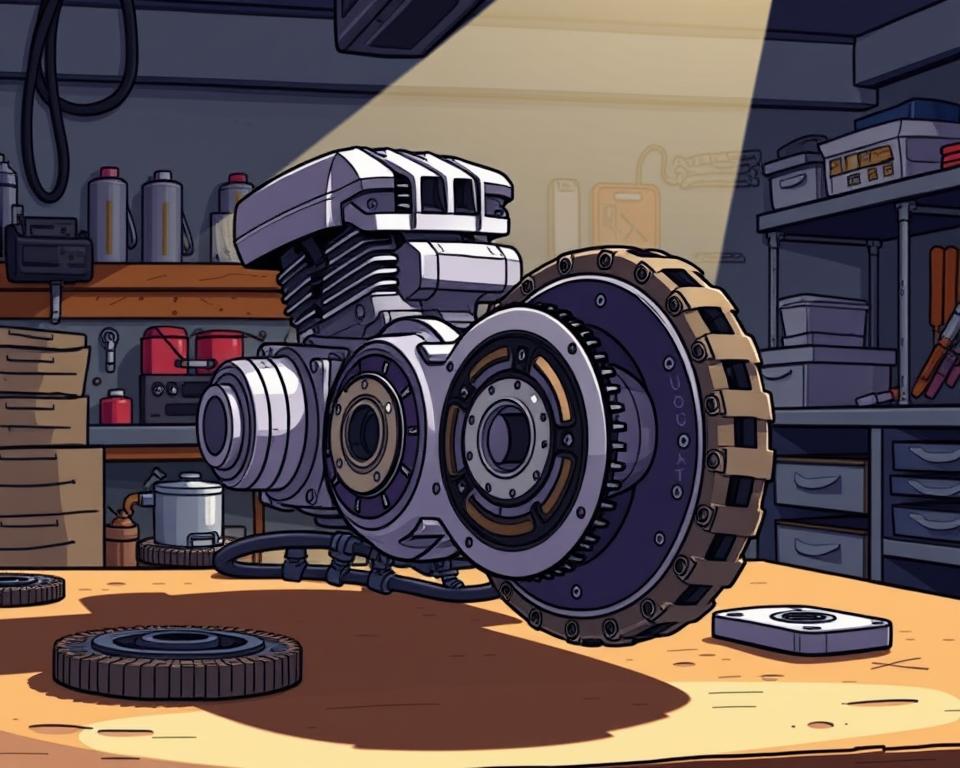How New Riders Can Avoid ATV/UTV Gear Selection Pitfalls
Can you believe that nearly 25% of new ATV and UTV owners face gear selection issues within their first year? Such data emphasizes how critical gear ratios are for novice riders. It’s not just about performance; it’s also about safety on the trails. We’ll explore common mistakes, maintenance practices, and expert can-am maverick doors advice to improve your off-road adventures.
Main Points

- Understanding gear ratios is vital for optimal ATV/UTV performance.
- Neglecting gearing details increases accident hazards.
- Scheduled upkeep stops gearbox failures.
- Smart gear choices transform your outdoor rides.
- Implementing ATV maintenance tips can prolong vehicle lifespan.
Understanding ATV and UTV Gear Ratios
Ratios determine how engine output translates to drive force. They govern both top speed and hauling capacity. That impacts hill climbs and tow capabilities. Custom gearing shifts focus from speed to torque or vice versa.
Choosing the right UTV gear is key to understanding engine performance. A low gear ratio can hinder torque during steep climbs or when carrying heavy loads. Conversely, too high a ratio hampers quick takeoffs on flats.
Many enthusiasts use gear reduction to enhance handling and adaptability across different terrains. Tuning ratios lets you fine-tune speed vs. torque. It perfectly aligns performance with your riding style. Optimal ratios deliver smoother use and better MPG.
Common Gearing Oversights for New ATV/UTV Owners
Proper gear choice underpins both power and protection. First-timers frequently ignore ratio considerations. Grasping misgear consequences and correct choices elevates your performance. And it sidesteps needless breakdowns.
Impact of Incorrect Gear Selection
Choosing the wrong gear can lead to serious problems, including loss of control and mechanical failures. The wrong gear can slow down acceleration, affect braking, and cause excessive wear. These mishaps compromise safety for all on and off board. Using maintenance best practices wards off these hazards.
Choosing the Right Gear for Terrain
Each surface demands its own ratio. To conquer grades, use lower speeds and higher torque. To cover ground quickly, shift to higher ratios. Soft ground demands careful gear choice for grip. Recognizing terrain traits delivers safer, smoother rides.
The Importance of Proper ATV Maintenance
Scheduled service avoids surprises on the trail. Following ATV maintenance tips helps avoid unexpected breakdowns and boosts safety. A smart maintenance regimen targets gearbox longevity.
Regular Inspection and Maintenance
A thorough inspection list catches troubles before they grow. Regularly inspect the drive train, stopping systems, wheels, and belts. Integrating inspections into your schedule boosts reliability. Here are some critical inspection points to remember:
- Check gear mesh and teeth condition.
- Ensure all fasteners are tight.
- Assess brake fluid and hydraulic systems.
- Verify tire PSI and rubber life.
- Review electrical systems for corrosion.
Fluid Changes and Gear Health
Fluid quality is critical for UTV drivetrain maintenance. Frequent changes clear out contaminants. Fresh oil cuts wear and heat for lasting components. Using this method secures dependable function and fewer breakdowns.
| Fluid Type | Recommended Change Interval | Benefits of Regular Change |
|---|---|---|
| Engine Oil | Every 50-100 hours | Cuts friction and boosts power |
| Gear Oil | 100–200 operating hours | Improves shifting, minimizes gear damage |
| Antifreeze | Once per year | Stops boil-overs and freezes |
By following these guidelines, enthusiasts can enjoy their rides without worrying about mechanical failures. It turns rides into stress-free experiences.
Common ATV Gear Shifting Problems
Many beginners wrestle with the gearbox. Learning silky shift methods transforms your ride. It reduces frustration on the trails. Timing throttle and clutch releases prevents gears from crunching.
Learning to Shift Smoothly
Building graceful shift habits demands consistent effort. First, feel your engine’s rev pattern. Smooth gear engagement reduces transmission stress and prevents issues. Blending throttle with clutch release ensures seamless shifts.
Drill shifts in an open space to build skill. Keep your throttle light when shifting.
Recognizing Signs of Gear Issues
Early detection of gear issues is essential. Watch for whines, clanks, or crunches in the gearbox. Stuck gears or false neutrals are warning signs. Fixing problems fast keeps you safer on the trail. Addressing ATV gear shifting problems properly maintains vehicle performance and boosts your confidence while riding.
Understanding UTV Transmission Issues
Dealing with UTV transmission problems can be tough, but knowing the common issues is vital for troubleshooting. Frequent complaints include gears that pop out and strange whines. This section delves into these frequent problems and offers a detailed approach to diagnose and fix them. It’s based on a practical UTV troubleshooting guide.
Diagnosing Common Problems
Identifying symptoms early prevents bigger issues. Common issues include:
- Slipping gears that threaten control and safety.
- Unusual sounds, such as grinding or whining, indicating mechanical damage.
- Leaking transmission fluid, potentially leading to more severe problems.
Routine checks uncover faults early. It lets you fix faults before they worsen. Overlooking warnings costs more in the long run.
Solutions for Troubleshooting UTV Transmissions
Repairing gearbox problems calls for methodical steps. Follow these steps for effective troubleshooting:
- Ensure gearbox fluid is at spec, then add if low.
- Look for wet spots beneath the transmission.
- Inspect the gearbox for wear or damage.
- Test drive the UTV at various speeds to monitor gear engagement and responsiveness.
- Reference factory troubleshooting charts for your UTV.
Leveraging a proven guide speeds up repairs. Grasping drivetrain theory helps maintain your rig. That insight preserves reliability and output.
ATV Clutch Adjustments and Their Benefits
Accurate clutch tuning unlocks seamless shifts. Misadjusted clutches cause jerky shifts and rider irritation. Frequent tuning enhances clutch grip and shift precision.
Precision in gear changes is critical. An optimally adjusted clutch ensures quick and smooth gear changes. This enhances the ATV’s power delivery, making rides more enjoyable on different terrains.
Ignoring clutch adjustments can harm performance and wear out parts. Consistent adjustments sustain peak clutch function. All riders benefit from clutch care to maintain top performance.
Mastering the Art of Gear Shifting
Excelling at transitions elevates your trail adventures. You need mechanical insight and precise timing to nail each shift. Novices must learn shift cadence. Consistent timing makes shifts effortless and more efficient.
Smooth shifts arise from varied-condition training. Recognizing terrain-specific shift cues boosts confidence and protection. Downshifting into grades safeguards momentum and balance.
- Practice shifting at low speeds to build confidence.
- Listen and feel each gear engagement.
- Step up to steeper, rougher trails as you improve.
Developing a feel for your machine is essential in mastering gear control. Pay attention to engine sounds and vibrations. These cues pinpoint exact shift timing. That instinctive skill yields seamless shifts and more fun.
Best Practices for UTV Gear Selector Problems
Tackling selector issues calls for scheduled checks and troubleshooting. Frequent selector checks prevent surprises. Perfecting selector methods wards off glitches. Routine checks should include visual inspections of the selector linkage and fluid levels, which are vital for performance.
When facing gear selector issues, first check the selector mechanism for obstructions or damage. Unusual noises can also hint at problems. A quick tighten or lube can restore function. Scheduled servicing prevents selector degradation.
Using a systematic approach, like documenting gear performance under different conditions, helps identify specific problems. These best practices not only extend the gear selector’s life but also make riding safer and more enjoyable.
Tips for Enhancing Gear Performance
Sustaining peak gear health involves systematic care. Routine service boosts ATV efficiency. It’s important to check fluid levels, inspect for wear, and adjust settings as needed. A simple inspection can prevent extensive damage and costly repairs.
Selecting proper reductions yields prompt acceleration and fluid movement. Understanding the terrain you will face allows you to select the appropriate ratios. It shapes your bike’s quickness and runway performance. Seeking parts from specialists such as American Off-Roads aids in UTV performance enhancements.
Implementing gear performance tips in wheels, springs, and ballast optimization elevates function. Making these adjustments ensures that both ATVs and UTVs handle better in challenging environments. This leads to a more enjoyable riding experience. These steps ensure fearless exploration and maximum excitement on the trail.
In Closing
Getting your gears right is the key to speed and security. Knowing how to choose the right gear for different terrains greatly improves your ride. By avoiding common mistakes and making smart choices, your off-road trips will be both fun and secure.
No less crucial is keeping your drivetrain in top trim. Regular checks and upkeep are key to avoiding problems and extending your vehicle’s life. Good upkeep maximizes output and secures your rides in all conditions.
Understanding gear selection and prioritizing maintenance leads to a more fulfilling experience for ATV/UTV fans. Embracing these tips sets the stage for countless epic journeys.
Frequently Asked Questions
Common ratio ranges for ATVs/UTVs?
ATVs and UTVs have gear ratios that vary widely, depending on the model. Most fall between about 3:1 and 5:1. Smaller ratios deliver grunt for trails and climbs. Higher ratios, on the other hand, can increase top speed on flat terrain.
How can I determine if I’m using the wrong gear for my terrain?
Wrong ratios cause skiddy control, engine lugging, or weak pull. Different grounds need dedicated ratios to maintain traction and speed.
What are some signs that my ATV/UTV needs maintenance?
Look out for signs like difficulty shifting gears, unusual noises from the transmission, fluid leaks, or a decrease in performance. Scheduling drivetrain inspections stops big failures.
Recommended fluid change intervals?
Change the gear fluids every 1,500 to 2,500 miles, or at least once a year, depending on usage and terrain. Fresh fluids promote crisp shifts and gearbox longevity.
Best practices for flawless shifts?
For smooth gear shifting, practice coordinating the throttle and clutch. Gradually release the clutch while pressing the throttle to match engine speed with wheel speed.
How can I troubleshoot UTV transmission issues?
Begin with fluid level checks and a listen for whines or grinds. Inspect the transmission fluid level and condition. Then, perform a basic diagnostic to identify any mechanical failures.
Why adjust your ATV clutch?
Well-set clutches ensure crisp gear changes. An improperly set clutch can cause shifting difficulties and may lead to premature wear on transmission components.
How can I improve my gear performance on different terrains?
Test multiple gearing options and look into quality mods by American Off-Roads. Routine upkeep—fluid swaps and gear checks—boosts efficiency.
When your UTV shifter sticks?
Regular inspections and routine maintenance are key. If you encounter issues with a stuck selector or improper gear engagement, consult the troubleshooting guide in your owner’s manual for step-by-step diagnostics.
Beginner pitfalls in gear selection?
Rookies tend to ignore ratio basics, delay upkeep, or misgear for mud, rock, or hills. Such errors cause subpar power delivery and increased accident risk.


